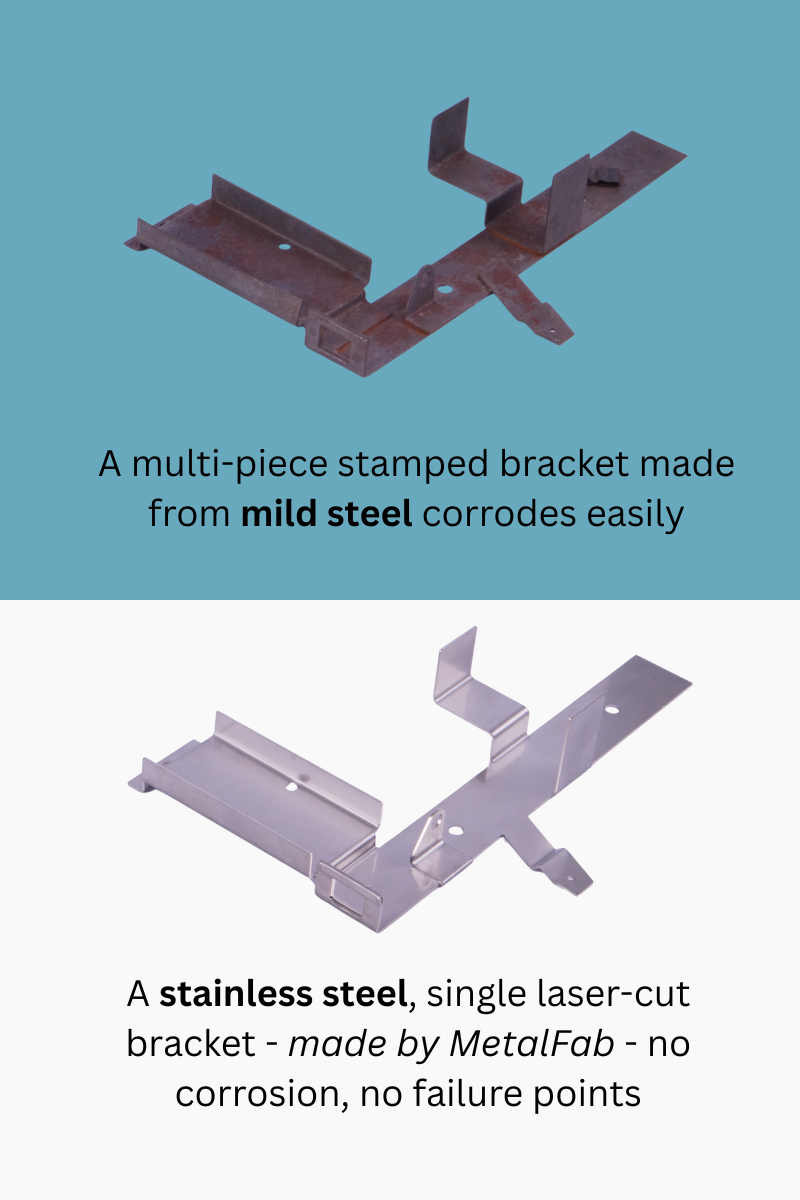NSF Compliance Checklist for Food Equipment Fabrication
- MetalFab Group
- Sep 10
- 4 min read
Updated: Sep 12
Food equipment fabrication demands more than metalworking expertise—it requires a deep understanding of NSF compliance that protects manufacturers and consumers alike. A single oversight can trigger failed inspections, costly redesigns, and production delays that devastate your bottom line.

This unofficial NSF compliance checklist covers the critical requirements that separate compliant food equipment from expensive failures that MetalFab Group actively follows when working on a variety of projects for our Food Industry clients. For a comprehensive guide, please refer to the latest information available at:
NSF International official standards (NSF/ANSI 2, NSF/ANSI 51)
We'll walk you through material specifications, design standards, and fabrication requirements that ensures NSF-compliant production.
NSF Compliance Vs. Certification
NSF compliance means ensuring your food equipment meets all necessary sanitation and safety standards laid out by the National Sanitation Foundation. NSF certification, on the other hand, is an official third-party approval demonstrating that equipment has been independently tested and verified to meet those standards. This post focuses on compliance within metalworking for food equipment fabrication.
Understanding NSF Compliance Standards for Food Equipment
The NSF (National Sanitation Foundation) sets rigorous standards for food service equipment, ensuring products meet strict sanitary design principles. NSF compliance isn't optional—it's mandatory for equipment used in commercial food processing, preparation, and service environments.
Non-compliant equipment faces rejection from health departments, equipment dealers, and end users. More importantly, compliance failures can lead to foodborne illness outbreaks, regulatory fines, and devastating liability claims.
Material Requirements for Food Equipment Fabrication
Approved Food-Grade Materials
304 stainless steel for standard food contact surfaces
316 stainless steel for high-chloride cleaning environments
316L stainless steel for welded applications requiring enhanced corrosion resistance
Material certifications from mill test reports required
Critical Material Restrictions
No galvanized steel in food contact applications
Carbon steel prohibited for direct food contact
Surface Requirements for Food Contact Areas
Surface finish specifications directly impact cleanability and bacterial adhesion.
Surface Roughness Standard - Maximum 32 Ra surface finish on food contact surfaces
Ra (Roughness Average) measures surface peak and valley heights
Lower Ra values indicate smoother, more hygienic surfaces
Enhanced cleanability reduces bacterial adhesion risk
Smooth, non-porous surfaces throughout
No exposed threads on food contact surfaces
Proper passivation of all stainless steel components
Electropolishing where specified for enhanced cleanability
Surface treatments must resist chemical cleaning agents
Sanitary Design Standards
Corner Radius Requirements
Minimum 3/16" radius on all internal corners
Smooth transitions eliminate bacterial harboring points
Rounded corners facilitate thorough cleaning
Sharp corners create dead spaces for contamination
Accessibility Standards
All surfaces accessible for cleaning and inspection
Removable components for thorough sanitation
Clear sight lines for visual inspection
No dead spaces where cleaning solutions accumulate
Structural Requirements
Welding and Joint Design
Smooth, continuous welds with no gaps or crevices
Ground and polished weld seams flush with base material
Full penetration welds for structural integrity
No horizontal surfaces that collect debris
Support Structure Design
Proper clearance (6" minimum) from floors and walls
Support structures don't create cleaning obstacles
Equipment legs and frames allow thorough floor cleaning
Mounting hardware resists corrosion and contamination
Fabrication Standards for Food Equipment
Welding Requirements
TIG Welding for Food Contact Surfaces: TIG welding provides superior results for food equipment fabrication. Unlike MIG welding, which produces spatter requiring extensive post-weld polishing, TIG welding:
Minimizes oxidation and discoloration on stainless steel
Maintains corrosion resistance critical for food processing
Produces smooth weld profiles without undercuts
Requires proper purge gas protection to prevent oxidation
Post-Weld Treatment:
Complete cleaning and passivation of all stainless steel
Surface finish restoration to specified Ra values
Heat tint removal indicating proper oxidation control
Dimensional verification confirming design specifications
Assembly Standards
Hardware and Fastener Requirements:
Stainless steel fasteners throughout food contact areas
Proper torque specifications prevent loosening
No lubricants on food contact threads
Sealed electrical connections preventing moisture ingress
Cost Impact of Non-Compliance
Direct Financial Costs
Complete equipment replacement when design cannot be corrected
Redesign and re-fabrication of non-compliant components
Extended project timelines due to compliance iterations
Third-party inspection fees for compliance verification
Legal and regulatory consultation for complex requirements
Hidden Costs and Long-Term Impact
Production delays during equipment replacement
Product recalls if contaminated products reach market
Regulatory fines for repeated compliance failures
Insurance premium increases following contamination events
Brand reputation damage from food safety incidents
Risk Mitigation Value: Understanding these costs highlights why proper NSF compliance represents smart risk management, not just regulatory necessity.
Conclusion
NSF compliance in food equipment fabrication requires systematic attention to materials, design, fabrication, and documentation. The investment in getting compliance right initially always costs less than retrofitting or replacing non-compliant equipment.
Success comes from treating NSF compliance as integral to the design process, not an afterthought. Every material selection, design decision, and fabrication technique must consider sanitary design principles and regulatory requirements.
The food industry demands equipment that protects public health while delivering operational efficiency. Partner with fabricators who understand that food equipment engineering fundamentally differs from general metalworking—it requires specialized knowledge, certified processes, and unwavering commitment to quality.
Ready to ensure your food equipment meets NSF requirements? Contact MetalFab Group for a comprehensive compliance consultation. Our ISO 9001:2015 certified processes and extensive food equipment experience help you avoid costly compliance failures while delivering equipment that exceeds regulatory standards.
MetalFab Group specializes in NSF-compliant food equipment fabrication, combining precision engineering with deep regulatory knowledge to deliver equipment that passes inspection every time.





Grant Pharmacy makes it easy to order amoxicillin online with trusted service and quick delivery.
Sanford Pharmacy is more than just a place to fill prescriptions – it is a trusted partner in your healthcare journey. Dedicated to offering quality medicines and reliable services, Sanford Pharmacy combines professional care with a personal touch.